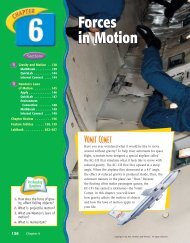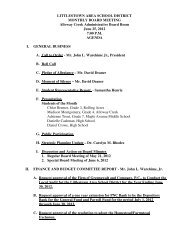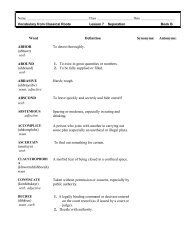Electromagnetism Electromagnetism
Electromagnetism Electromagnetism
Electromagnetism Electromagnetism
Create successful ePaper yourself
Turn your PDF publications into a flip-book with our unique Google optimized e-Paper software.
Magnetic Force and Electric Current<br />
At the beginning of this section you learned that an electric<br />
current can cause a compass needle to move. The needle, a<br />
small magnet, moves because the electric current in a wire creates<br />
a magnetic field that exerts a force on the needle. If a<br />
current-carrying wire causes a magnet to move, can a magnet<br />
cause a current-carrying wire to move? Figure 16 shows that<br />
the answer is yes.<br />
Figure 16 A magnet exerts a force on a current-carrying wire.<br />
a When a current-carrying wire is<br />
placed between two poles of a<br />
magnet, the wire will jump up.<br />
b<br />
Applications of <strong>Electromagnetism</strong><br />
<strong>Electromagnetism</strong> is useful in your everyday life. You already<br />
know that electromagnets can be used to lift heavy objects<br />
containing iron. But did you know that you use a solenoid<br />
whenever you ring a doorbell or that there are electromagnets<br />
in motors? Keep reading to learn how electromagnetism makes<br />
these devices work.<br />
Doorbells Many doorbells contain<br />
a solenoid with an iron rod inserted<br />
part way in it. The electric current in<br />
the solenoid is controlled by the doorbell<br />
button. When you press the button,<br />
a switch in the solenoid circuit<br />
closes, creating an electric current in<br />
the solenoid. What happens next is<br />
shown in Figure 17.<br />
Copyright © by Holt, Rinehart and Winston. All rights reserved.<br />
If the direction of the electric current<br />
in the wire is reversed, the wire is<br />
pushed down instead of up.<br />
Figure 17 An electric current in the<br />
solenoid of a doorbell produces a<br />
magnetic field. This field pulls<br />
the iron rod through the<br />
solenoid, and the rod<br />
strikes the bell.<br />
<strong>Electromagnetism</strong> 465





